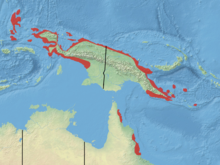Spectacled Flying Fox
| Spectacled flying fox | |
|---|---|
 |
|
| Male, female, and their young | |
| Scientific classification | |
| Kingdom: | Animalia |
| Phylum: | Chordata |
| Class: | Mammalia |
| Order: | Chiroptera |
| Family: | Pteropodidae |
| Genus: | Pteropus |
| Species: | P. conspicillatus |
| Binomial name | |
|
Pteropus conspicillatus Gould, 1850 |
|
 |
|
| Distribution of the spectacled flying fox | |
The spectacled flying fox (Pteropus conspicillatus), also known as the spectacled fruit bat, is a megabat that lives in Australia's north-eastern regions of Queensland. It is also found in New Guinea and on the offshore islands including Woodlark Island, Alcester Island, Kiriwina, and Halmahera.
The spectacled flying fox was listed as a threatened species under the Commonwealth Environment Protection and Biodiversity Conservation Act of 1991. They were considered vulnerable due to a significant decline in numbers as a result of loss of their prime feeding habitat and secluded camp sites. It has also been reported that spectacled flying foxes skim over the surface of water to drink and are sometimes eaten by crocodiles. The species was classified as "least concern" by the IUCN in 2008.
The head and body length is 22–25 cm, forearm 16–18 cm, weight 400–1000 g. A large spectacled flying fox has pale yellow or straw-colored fur around its eyes. The mantle is pale yellow and goes across the back, neck, and shoulders. Some have pale yellow fur on the face and top of the head.
Spectacled flying foxes are forest dwellers and rainforests are their preferred habitat. They prefer to roost in the middle and upper canopy strata in the full sun. Colonies of the spectacled flying fox can be found in rain forests, mangroves, and paperbark and eucalypt forests. No colony is known to be located more than 7 km from a rainforest.
The spectacled flying fox's natural diet is rainforest fruits, riparian zone flowers, and flowers from Myrtaceae (primarily Eucalyptus and Syzygium species) and fruits from the Moraceae (figs) and Myrtaceae (primarily Syzygium).
Spectacled flying foxes have one pup annually. Females are capable of breeding at one year of age. Males probably do not breed until three to four years of age. They are polygamous (similar to the grey-headed flying fox, Pteropus poliocephalus). Female to male ratio may be as high as 2:1. Conception occurs April to May. Sexual activity is continuous from about January to June. Females give birth to one young per year in October to December. Juveniles are nursed for over five months, and on weaning, congregate in nursery trees in the colony. The juveniles fly out for increasing distances with the colony at night and are 'parked' in nursery trees, often kilometres distant from the colony, and are brought back to the colony in the morning.
...
Wikipedia

